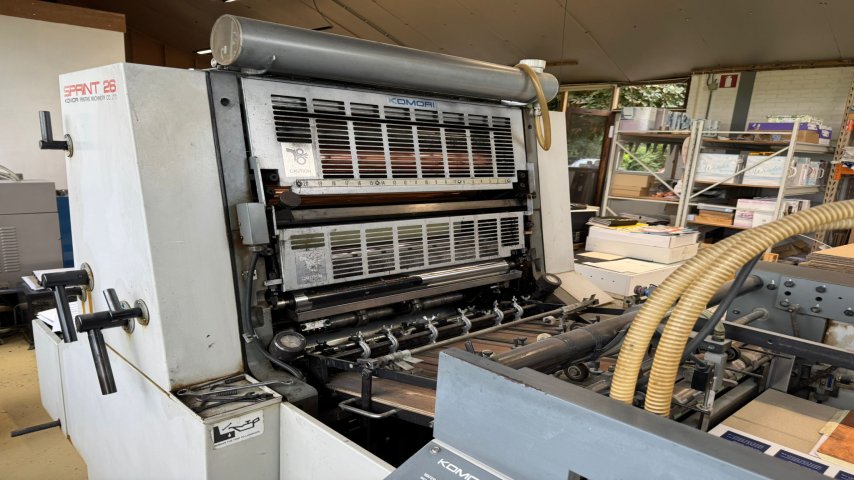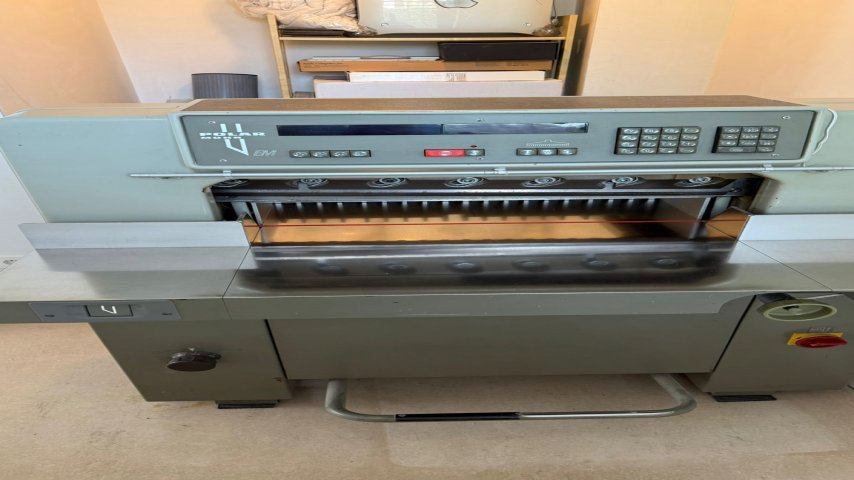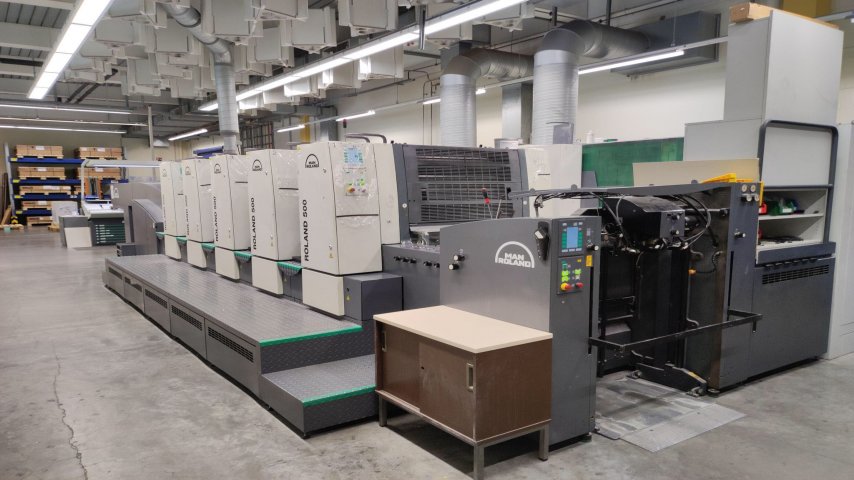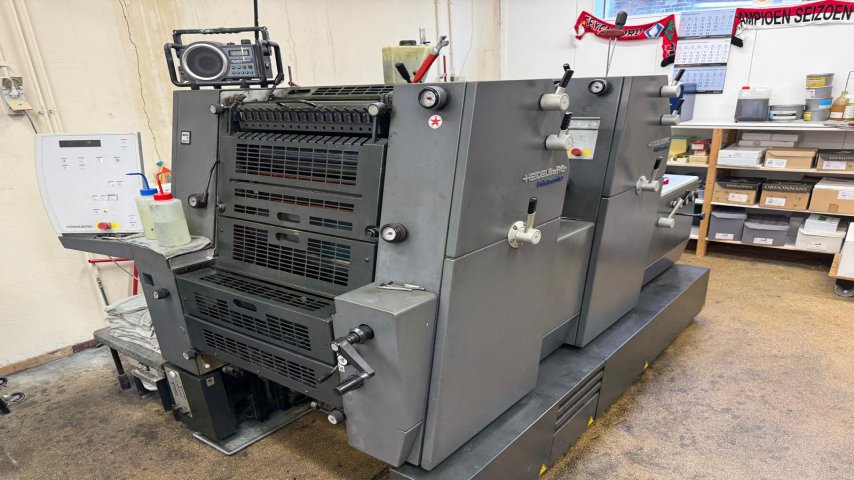- Home
-
Machinery List
Machinery List (148) Stocklist (144) Sheet Offset (23) Converting (109)All Guillotine (16)Folding Machine (18)Perfect Binding (6)Saddle Stitching (4)Gathering (4)Miscellaneous (60)Cross Feeder (1)Web Offset (1) Paper Converting (4) Solid Board Converting (2) Corrugated Board Conv. (2) Preamplifiers (4) Accessory (3)
- Sell machine
- Service
- Contact
Cross-fold
Date: 2019-03-06

What Is a Cross-Fold?
A cross-fold refers to a specific folding process in which a printed sheet is folded in two directions. First, the sheet is typically folded in a standard direction (often a parallel or parallel fold), and then it is passed through another set of rollers or a folding mechanism to make a second fold in the opposite direction. The result is a paper that is folded in a crosswise pattern, creating a compact, multi-panel structure.
This method is commonly used in producing brochures, maps, flyers, and other materials that require multiple panels for information. The beauty of the cross-fold lies in its ability to create clean, precise folds that align perfectly, even in high-speed production environments.
The Cross-Fold Process
1. First Fold: Preliminary Folding
The first step in the cross-fold process is the primary fold. Typically, this involves folding the printed sheet along its length or width, depending on the desired outcome. This initial fold sets the stage for the second fold and ensures that the paper is divided into the correct panels or sections. The alignment of the first fold is critical for achieving accuracy in the second fold, which is where the precision of the entire cross-fold process lies.
2. Second Fold: The Cross-Fold
After the initial fold, the sheet moves to a second set of rollers, where it is folded again in the opposite direction. This creates a "cross" pattern, with the panels aligning perpendicular to the original fold. In this step, it’s important for the machine’s settings to be finely tuned, as slight misalignments can lead to inaccurate folds and affect the quality of the final product.
The second fold, or cross-fold, is often responsible for the final size of the printed piece, determining how compact the final product will be. Whether you are creating a four-panel brochure or a more complex eight-panel brochure, the second fold plays a pivotal role in ensuring that the panels are aligned correctly and that the printed materials can be easily folded and handled without causing damage.
Benefits of the Cross-Fold Technique
1. Efficient Use of Paper
The cross-fold technique is highly efficient when it comes to paper usage. By creating multiple panels from a single sheet, it reduces the amount of material required to create brochures, flyers, or similar products. This not only reduces waste but also helps to lower production costs, making it a cost-effective solution for printing multiple-panel materials.
2. Enhanced Presentation
A well-executed cross-fold provides a neat, professional finish that enhances the visual appeal of the printed material. When printed content is folded accurately into multiple panels, it creates a polished look that is ideal for marketing materials, product brochures, and informational pamphlets. The crispness of the folds ensures that the printed images or text are clear and easy to read, adding to the overall quality of the printed piece.
3. Increased Versatility
Cross-folds are incredibly versatile and can be adapted to a wide range of products. Whether you’re producing a simple four-panel brochure or a more complex eight-panel booklet, the cross-fold technique can be adjusted to accommodate different sizes, paper types, and designs. This flexibility makes it an ideal solution for print shops that need to cater to a variety of client needs.
4. Precision and Consistency
In high-quality printing environments, consistency is key. Cross-folding allows for precise, uniform folds that ensure that each piece in a print run is identical in terms of its fold structure. This consistency is essential for maintaining quality across large production runs and for ensuring that the end product meets the client’s specifications every time.
5. Time-Saving
Once set up properly, the cross-fold process is highly efficient and time-saving. The ability to create multiple panels from a single sheet in a continuous, automated manner significantly speeds up the folding process. This efficiency is crucial for print shops that have tight deadlines or high-volume orders, enabling them to produce a larger quantity of folded materials in a shorter amount of time.
Applications of Cross-Folding
The cross-fold technique is widely used in a variety of printing applications, including:
Brochures and Pamphlets: Creating promotional materials with multiple panels for detailed information.
Booklets: Ideal for creating small booklets with several pages of content.
Maps: Folding maps into a compact, easy-to-carry format with precise folds.
Menus and Catalogs: Multi-panel presentations of products or services that are easy to navigate and handle.
This technique is particularly valuable in the production of marketing materials and publications that need to fit a lot of information into a small, portable package.
Conclusion
The cross-fold is an essential technique in the print finishing world, providing versatility, precision, and efficiency in producing multi-panel materials. Whether it’s for a marketing brochure, a catalog, or a detailed map, the ability to create clean, sharp folds across two directions ensures the finished product is not only functional but also aesthetically pleasing. With the right equipment and a finely tuned process, cross-folding can help print shops deliver high-quality, cost-effective printed materials with speed and consistency.
Author: Ahmet Karakus
Tags: Bogenoffset; Digitaldruck; Papierbeutelmaschine; Papierverarbeitung; Rollenoffset; Vollpappe Verarbeitung; Vorstufengeräte; Weiterverarbeitung; Wellpappe Verarbeitung; Zubehör; 1 Farben; 2 Farben; 4 Farben; 5 Farben; 6 Farben; 7 Farben; 8 Farben; 3 Farben; 10 Farben; Verschiedene; Flach&Seitenfaltenbeutel; Klotzbodenbeutel; Kreuzbodenbeutel; Zweinahtbeutel; Druckwerke; Verschiedene; Prägemaschine; Stanztiegel; Stanzzylinder; Querschneider; Rollenschneider; Verschiedene; Zeitungdruck; Akzidenzdruck; Endlosdruck; Etikettendruck; Flexodruck; Tiefdruck; Verschiedene; Etikettenstanzen; Faltschachtelklebe; Autoplatine; Stanztiegel; Fenstereinklebe; Schachtelueberzieh; Verschiedene; CTP-Anlage; Filmbelichter; Plattentwicklungsmaschine; Filmentwickler; Kopiermaschine; Plattenkopierer; Verschiedene; Schneidemachine; Falzmachine; Klebebinder; Sammelhefter; Dreischneider; Zusammentrag; Fadenheft; Buchdeckmaschine; Buchfertigungsstrassen; Verschiedene; Drahtheftmaschinen; Einsteckmaschinen; Kreuzleger; Casemaker; Druckslotter; Hefter & Kleber; Laminiermaschine; Autoplatine; Stanztiegel; Verschiedene; Diverse Geräte; Walzen; Nummerierer werke; Sheet Offset; Digital Print; Paper Bag Making; Paper Converting; Web Offset; Solid Board Converting; Prepress Equipment; Converting; Corrugated Board Conv.; Accessory; 1 Color; 2 Colors; 4 Colors; 5 Colors; 6 Colors; 7 Colors; 8 Colors; 3 Colors; 10 Colors; Miscellaneous; Flat & Satchel; Block Bottom; Cross Bottom; Twin Seam; Print Units; Miscellaneous; Foil Stamping; Handplaten; Punching cylinders; Sheeter; Slitter Rewinder; Miscellaneous; Newspaper; Commercial; Business Form; Label machine; Flexo machine; Gravure; Miscellaneous; Label Punching; Folder Gluer; Autoplaten; Handplaten; Window Patcher; Box Coverer; Miscellaneous; CTP; Film Exposure; Plate developer; Film developer; Copy Box; Plate Copy; Miscellaneous; Guillotine; Folding Machine; Perfect Binding; Saddle Stitching; Three Knife Trimmer; Gathering; Sewing; Block Processing; Book production lines; Miscellaneous; Stitching Machine; Inserting Machines; Cross Feeder; Casemaker; Print Slotter; Gluer & Slitcher; Laminator; Autoplaten; Handplaten; Miscellaneous; Other Device; Roller; Numbering device; Baski Ofset; Dijital Baski; Kagit Torba Makinesi; Kagit Isleme; Rulo Ofset; Kati Karton Isleme; Ön Hazirlik Cihazlari; Ileri Isleme; Dalgali Karton Isleme; Aksesuar; 1 Renk; 2 Renk; 4 Renk; 5 Renk; 6 Renk; 7 Renk; 8 Renk; 3 Renk; 10 Renk; Çesitli; Düz ve Çanta Tipi; Kare Taban Çanta; Çapraz Taban Çanta; Ikili Dikisli Çanta; Baski Ünitesi; Çesitli; Yaldiz Baski; Elle Basma Makinesi; Döner Silindiri; Kesici; Rulo Kesici; Çesitli; Gazete Baskisi; Ticari Baski; Sürekli Form Baski; Etiket Baskisi; Flexo Baski Makinesi; Derinlik Baskisi; Çesitli; Etiket Düzlemesi; Kutu Yapistirma; Otomatik Platen; Elle Basma; Pencere Kapama; Kutu Kapatma; Çesitli; CTP; Film Pozlama; Plaka Gelistirici; Film Gelistirici; Kopya Makinesi; Plaka Kopyalama; Çesitli; Kesme Makinesi; Katlama Makinesi; Mükemmel Ciltleme; Zimbalama; Üçlü Kesici; Toplama; Dikisli Ciltleme; Blok Isleme; Kitap Üretim Hatlari; Çesitli; Dikis Makinesi; Yerlestirme Makinesi; Çapraz Besleyici; Kitap Kapatma Makinesi; Baski Slotteri; Yapitirici & Zimba; Laminatör; Otomatik Platen; Elle Basma; Çesitli; Diser Cihazlar; Rulo; Numaralandirci Cihaz; Impression feuille à feuille; Impression numérique; Machine à fabriquer des sacs en papier; Traitement du papier; Impression offset en bobine; Transformation de carton plein; Équipements de prépresse; Transformation; Transformation de carton ondulé; Accessoire; 1 Couleur; 2 Couleurs; 4 Couleurs; 5 Couleurs; 6 Couleurs; 7 Couleurs; 8 Couleurs; 3 Couleurs; 10 Couleurs; Divers; Type Plat et Sac; Sac de Fond Carré; Sac de Fond Croisé; Sac à Double Couture; Unité d'Impression; Divers; Impression Dorée; Machine de Stamping Manuel; Cylindre Rotatif; Coupeuse; Coupeuse de Rouleaux; Divers; Impression de Journal; Impression Commerciale; Impression de Formulaires Continus; Impression d'Étiquettes; Machine Flexo; Impression en Profondeur; Divers; Mise en Forme des Étiquettes; Collage de Boîtes; Platen Automatique; Estampage Manuel; Fermeture de Fenêtres; Fermeture de Boîtes; Divers; CTP; Exposition de Film; Développeur de Plaques; Développeur de Film; Machine de Copie; Copie de Plaques; Divers; Machine de Coupe; Machine de Pliage; Reliure Parfaite; Agrafeuse; Coupeuse Triple; Rassembleuse; Reliure Cousue; Traitement de Blocs; Lignes de Production de Livres; Divers; Machine à Coudre; Machine de Placement; Alimentation Croisée; Machine de Fermeture de Livres; Slotter d'Impression; Colle & Agrafe; Laminateur; Platen Automatique; Estampage Manuel; Divers; Autres Équipements; Rouleau; Compteur de Nombres; Impresión offset de hojas; Impresión digital; Máquina para hacer bolsas de papel; Procesamiento de papel; Impresión offset de rollo; Procesamiento de cartón sólido; Equipos de preimpresión; Conversión; Procesamiento de cartón corrugado; Accesorio; 1 Color; 2 Colores; 4 Colores; 5 Colores; 6 Colores; 7 Colores; 8 Colores; 3 Colores; 10 Colores; Varios; Tipo Plano y de Bolsa; Bolsa de Fondo Cuadrado; Bolsa de Fondo Cruzado; Bolsa de Doble Costura; Unidad de Impresión; Varios; Estampado en Oro; Máquina de Estampado Manual; Rodillo Rotativo; Cortadora; Cortadora de Rodillo; Varios; Impresión de Periódico; Impresión Comercial; Impresión de Formato Continuo; Impresión de Etiquetas; Máquina de Impresión Flexográfica; Impresión de Profundidad; Varios; Planteamiento de Etiquetas; Pegado de Cajas; Platen Automático; Estampado Manual; Cierre de Ventanas; Cierre de Cajas; Varios; CTP; Exposición de Película; Desarrollador de Placas; Desarrollador de Películas; Máquina de Copias; Copia de Placas; Varios; Máquina Cortadora; Máquina de Plegado; Encuadernación Perfecta; Engrapadora; Cortadora Triple; Recogedor; Encuadernación con Costura; Procesado de Bloques; Líneas de Producción de Libros; Varios; Máquina de Coser; Máquina de Colocación; Alimentador Cruzado; Máquina de Cierre de Libros; Slotter de Impresión; Pegamento & Engrapado; Laminador; Platen Automático; Estampado Manual; Varios; Otros Equipos; Rollo; Contador de Números;Agfa; Agrafix; Baumann; Baumüller; BIMEC SRL; Bindomatic; BITS VOF; Bobst; C.P. Bourg S.A./N.V.; Cito; Cyklos; DAKIOU; DERITEND; Duplo; EBA; Eigenbau (Self-build); Elcos; Eurofold; Eurotechnica; FKS; Foliant; Fuji; Fujifilm; Gallus; GBC; Glunz & Jensen; GUK; Halm; Hang; Heiber + Schröder; Heidelberg; Heidelberg Stahlfolder; Hohner; Horizon; INATEC; Italdibipack; Jagenberg; Josef Foellmer; Kahl; KAS; KBA; KMK; Knorr; Kolbus; Komori; Krause; König & Bauer (KBA); Lintec; MAN Roland; Masterline; Mathias Bäuerle / Baeuerle; Mathias Bäuerle / MB-Bäuerle; Matrix; Max Simmel; MBO; Meccanotecnica; Minolta; Mitsubishi; Mueller Martini; Multigraf; MUTOH; Müller Martini; Nagel; Neolt; Neschen; Nilpeter; OMM; OMMA; Pandway; Perfecta; Pitney Bowers; Plockmatic; Poege; Polar; Polar Mohr; Polyair; Robapac; Robatech; Roland; Ryobi; Sakurai; SCREEN; Screen/FujiFilm; Shinohara; Shoei; Solema; SPS Rehmus; Stahl; Stenz Feeder; Stock; Stube Foerdertechnik GmbH; Thando; Theisen & Bonitz; Viprotech; VITS; Wahli-Stream Feeder; Wohlenberg; 1000 LM laminator; 103 F. AU Pallet turner; 106-MTF autom. foil stamping and die cutting; 107-30; 108 Double head paperdriller; 115; 115 ED; 115 EM-MONITOR; 115 MCS 2 TV; 137 EMC; 14 Tonnen Forklift; 1500-BMY Semi Autom. Die Cutting & Creasing Machin...; 168 HTVC + Basa 7; 185-1; 2 head drilling machine; 201 DFS; 235-121; 280 B; 2L 450EC; 300; 310+; 321; 340 Punch and Closing; 3501 Splitting SAW; 400/4; 4000; 52-2; 522 H; 522 HE; 524 GX; 551; 76 EM; 78 ES; 78 X; Abkantgerät Auto; AC 8000S; ACENTO II S (Screen PlateRite 4300S); Acoro A7; Airspace 9000; APC-T61 hydraulic cutter; Babypack; bizhub press C71hc; BQ 140; BQ 240; BQ 440; Bravo S; BS 25002 PUR; BSW 2/500 L pile turner; BY-800F Autom. Foil Stamping & Creasing Machine; C64-50 autofeed die cutter; CardExtra; CAS 35/2 PBA; CAS 52-4/4; CAS 524 SE; CB 16 stacker; CD 74 (machine parts); CD 74-5-P-C; City 5000; CM-1500A (2R) Roll to Sheet machine; COLDLAM 1400-NE; Compacta C618 48 pages; Conveyor Belt; Creo Magnus 400; cut-tec 76; DB 200; DC 8000 S; DI 425; Diamond 3000 S -5; Digifold creasing and folding machine; Dortmund-Kraft; Double head paperdriller; DUPLO DBMI DSC10/60I line; E3304 cutting machine; EK 420; EM 280; ES 5040 21; Eurobind 600; Exposure-washout-dryer unit Polimero A4; EXS-700 Strapping Machine; F-1050 K Window patcher machine; FA 35/2; Flexo 1600; Folding units for first pocket; FT250 Manual Foam Trim Pro 250; GM 5 Spine taping machine; GMP 450; GT; GTO 46; GTO 46 with N+P; GTO 52-2; GTO 52-2 NP; GTO FPP - 52; GTOV 52; GTOV-S 52; GTOVP 52; GTOZ 52; GTOZP-52; GTOZP-S 52; GYKM-2800 Printer Slotter Inliner; HBJ-D1200 Paper board erecting forming machine; HBJ-D800; HM 6 duble head magazin stitching; Horizon semiautomatic screen printing machines; Iram 16; JET LAM 1600; JP-TWOD-6D; K 52/4 KL - F4; K 820-6 KTLT; KC 56/4 KTL; KD 78/6 KTL; KH 78-4-KTL-RFH-82; KM 600; KSD; L-1000-G-3BF; L375D Laminator; LD 901 Map Folder; Lega 80 - Pressstation; Letterpress museum piece; Lithrone LSX-629 H+F+C+E+D (H-UV-L); LL-600-K-3; LPM 360 Laminating; Mach Eight; Magnus 800 Quantum; Mailmaster 565HS; Mariner 2 perforating machine; Master E; Masterline 410T; MC 8; Merit / 3671; MO Numbering & Perforating Unit; MOZP; MR 500; MULTIGRAF 252 CREASER / PERFORATOR; Multinak S; OD-4012; OHT; P460 Wiro Punching; PB 1006 1 Head drilling; PB 2015 drilling machine; Perfect binder with PUR; Platewriter 2400; Plocmatic 1000 Collating and Stitching Line; PM 52-1 NP; PM 52-2-P; PM 52-4-P; PM GTO 52-2 + with numbering + perforating; prestige FOLDNET 52; PSV 600; PT-R 4100; PT-R 4300; PT-R 4300 E; PT-R 4300 E/ Luxel T 6300 CTP; QRV Variocut; R 506 OB LV; R 705 3B LW; R 705 P 5/0 - 2/3; R 706 3B; RAPIDA 162A 6+lak PWVA ALV3; Roba 40 nozzle glue system; ROBOTAPE 50 M; ROTADIE 15; RSP Easy (Perforating tool); SA 145 APK; SBG; SDD BLM6100 Booklet Maker; SHL 12 P pile lift; SL 12 P; SL 40 Stack Lifter; SL-2-V-E; SM 52 - 5P3; SM 52-2; SM 74 4-P3-H; SM 74 Numbering & Perforating Unit; SM1-600; SORKZ; SORM; SP 1120-E; Stahlfolder TI 52-4-X; Stahlfolder TI 52/6 Proline; Star; Stitching machine; StitchLiner 5500; Suprasetter A52/A74; SX 74-2-P; T 36/4 - F.2; T 530 - 3 - X; T 530-1-53/4 F; T 530-1-53/4F; T 800 4-4-X; T 960-1-960/4; T 960-1-960/4 T 960-2-960/4; T49/4.KB-F.2; TCS 250; TM 530; TMA-20; TP; TrimScor DC545; Twin Screw Extruder LTW 160; UC 1100 Collator; VAC-100a; VALUEJET VJJ-1624; VFZ 52; Vipromat-S semiautomatic screen printing machines; Vitessa Classic Screen Printing with UV Dryer; WJ-1800 Corrugated cardboard making machine; WP 1400 matic window patcher; WP 76; XL 106-4; XL 75-5-P+L C; Z2 Mobile Knife Folding Unit; ZLFM-1080SC Autom. Laminating Machine + powder cle; ZLFM-800SC Autom. Film Laminating Machine + powder; ZLFM-800SJ Autom. Filmlaminiermaschine
Graphische Okkasionen Karakus
Our work consists of the international trade with graphic machines and equipments. Good contacts and over 25 years of experience assure our position on the international market.We distinguish ourselves through serious and uncomplicated handling. Our Monteure are guarantors for satisfied clients.
Imprint
Disclaimer
Blog
Manufacturer information
Specials Machinery
Contact
D-41849 Wassenberg
Tel: +49 - (0) 2432-98 595-0
Fax: +49 - (0) 2432-98 595-29
Email: info@gok-karakus.de







